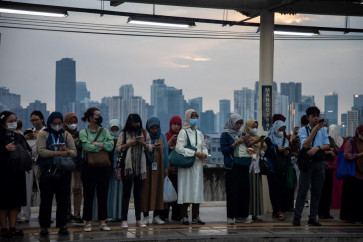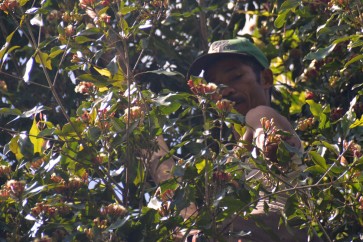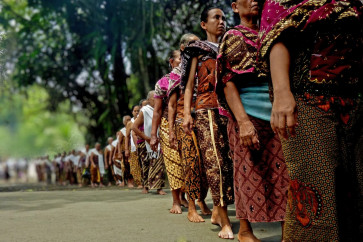Popular Reads
Top Results
Can't find what you're looking for?
View all search resultsPopular Reads
Top Results
Can't find what you're looking for?
View all search resultsThe world needs to secure its food resources
Extreme weather, rapid population growth – an estimated world population of 9 billion by 2050 – and other aggravating factors, like the diversion of food crops to biofuel production, are steering the world into an uncertain era
Change text size
Gift Premium Articles
to Anyone
E
xtreme weather, rapid population growth – an estimated world population of 9 billion by 2050 – and other aggravating factors, like the diversion of food crops to biofuel production, are steering the world into an uncertain era. Agricultural experts, policy makers, scientists and farmers from 127 countries recently met in Nusa Dua, Bali, at a conference on biodiversity, food security and climate change. The Jakarta Post’s Rita A. Widiadana and Desy Nurhayati report the latest global efforts in securing world’s food resources.
Changing times: A farmer works in a rice field in Sideman, Bali. JP/Agung ParameswaraWayan Sukabuana was once a wealthy and successful farmer from Tabanan regency, Bali’s major rice-growing area. Working on fertile terraced rice fields in Jatiluwih village, Wayan and 80 other farmers in the area were able to produce enough rice and other crops to make a living, under the island’s centuries-old and sustainable Subak farming system.
Today, like an estimated 500,000 farmers on the island of Bali, Wayan has to put up with myriads of problems — uncertain weather, rocketing prices of seeds and fertilizers, shrinking rice field areas and diminishing water resources.
Thousands of miles away on the highlands of the Andes in Peru, South America, Alejandro Argumendo is dealing with the same problems.
“Climate change has a dramatic effect in mountainous areas. We are indigenous farmers in the Andes, which is one of the hotspots in the world, in terms of climate change,” Alejandro told The Jakarta Post on the sidelines of the conference in Nusa Dua.
The effects of climate change, he said, have taken a turn for the worse, with landslides, heavy rains, the impact of El Niño, hurricanes and snow destroying most of their potato crop.
While Asian farmers grow rice as a staple food, their counterparts in Peru grow potatoes, he said.
Potatoes are important for them, not only as the main staple food but also in terms of culture.
“Potatoes are used in wedding ceremonies and other traditional rituals.
“Therefore, the potato is important for social, cultural and also economic reasons, because as a potato farming community, we depend on that commodity for income.”
Over the last 20 years or so, potato farming has had to move farther up in the mountains in order to adapt to the extreme changes in weather, he said.
Elsewhere in the world, around 1.5 billion farmers have been grappling with these changing weather conditions. For most farmers, fewer harvests mean less income. Worst of all, if food production decreases, more people are at risk of starving and poverty.
Clive Stannard, an expert from the Food and Agriculture Organization (FAO), told the Post that climate change is a major threat to world food security.
The Bali conference took place as the world is on the verge of a food crisis. A handful of climatic events in the last year and this year — such as droughts in Russia and China, and floods in Australia and Pakistan — have contributed to a 29 percent increase in food prices, which are now higher than they have been in decades.
The swift rise in food prices is alarming because of its potential to deepen poverty and cause political instability.
“The growing number of extreme weather events — long droughts, floods, hurricanes, the likelihood of pest and disease migrations will have devastating impacts on crop production, especially in the tropical and subtropical regions of South Asia, Southeast Asia and Africa,” Stannard said, adding that crop yields were predicted to decrease by 20 to 40 percent a year.
According to him, the current food crisis and increasing food prices are a problem in every part of the world — in developed as well as developing nations.
“The problems are already on our doorsteps and dining tables. They are about the amount of food any family can buy and the decreasing amount of staple foods and other supplementary foods currently available in the markets,” he said.
Amid plenty: Vendors and shoppers haggle amid a variety of fruits and vegetables at Pasar Jembatan Lima in West Jakarta. JP/Ricky Yudhistira “With climate change already altering farming conditions and the population rapidly increasing, preserving and sharing crop diversity on a global scale is no longer optional,” said Shakeel Bhatti, the secretary of the Treaty’s governing body.
“No country – rich or poor – has within its borders the crop diversity required to meet future food needs. All countries need to improve the way they share their seeds and crop material as a matter of great urgency,” Bhatti added.
FAO’s data shows the food crisis has increased the number of hungry people (people with an insufficient calorie intake) from 840 million in 2003 to 1 billion in 2010, a 160 million increase in less than six years. The most alarming fact is that one child dies every five seconds from a hunger-related illness.
Of the world’s 6.6 billion people in 2009, close to one-third suffer from hunger and malnutrition. But, there are 1.3 billion obese and overweight people, mostly in developed countries in the Global North.
Pepe Esquinas-Alcázar, a professor and director of the Center for Studies on Hunger and Poverty at the University of Cordoba in Spain, shared with the Post that the 20th century had been a time of uniformity and standardization. The 21st century has to be the century of diversity.
“You can only select what you need if there is diversity. If everything is homogenous, you don’t have anything to select. That is the idea – the importance of biodiversity. Less diversity means more vulnerability.”
In the 20th century alone, more than 90 percent of the diversity that existed in the field for the most important crops has disappeared.
According to the FAO, humankind had used more than 7,000 different species to produce food throughout history. Presently, in the 21st century, people only cultivate around 150 species and only four of them — wheat, maize, potatoes and rice — provide more than 60 percent of the calorie intake of humankind.
Crisis: A young boy suffers from malnutrition in South Jakarta. When the boy was two years old, he only weighed 7 kilograms. JP/Ricky Yudhistira Data shows that two thirds of the world’s food is generated from only 12 plants and five animal species, a situation that is threatening global food security and health in general.
“That was an indirect consequence of the green revolution, aimed at increasing the productivity of plants, to produce more food at a lower cost. But at the same time, it has substituted millions of varieties into uniformed, homogenous varieties,” explained the professor who is a former secretary on genetic resources for food and agriculture.
“We are destroying the basis of agriculture and food, without which it is impossible to face the unpredictable environmental changes and human needs in the future.”
“Therefore, the cooperation of countries and continents worldwide to solve this kind of problem is not a choice, it is a must.”












